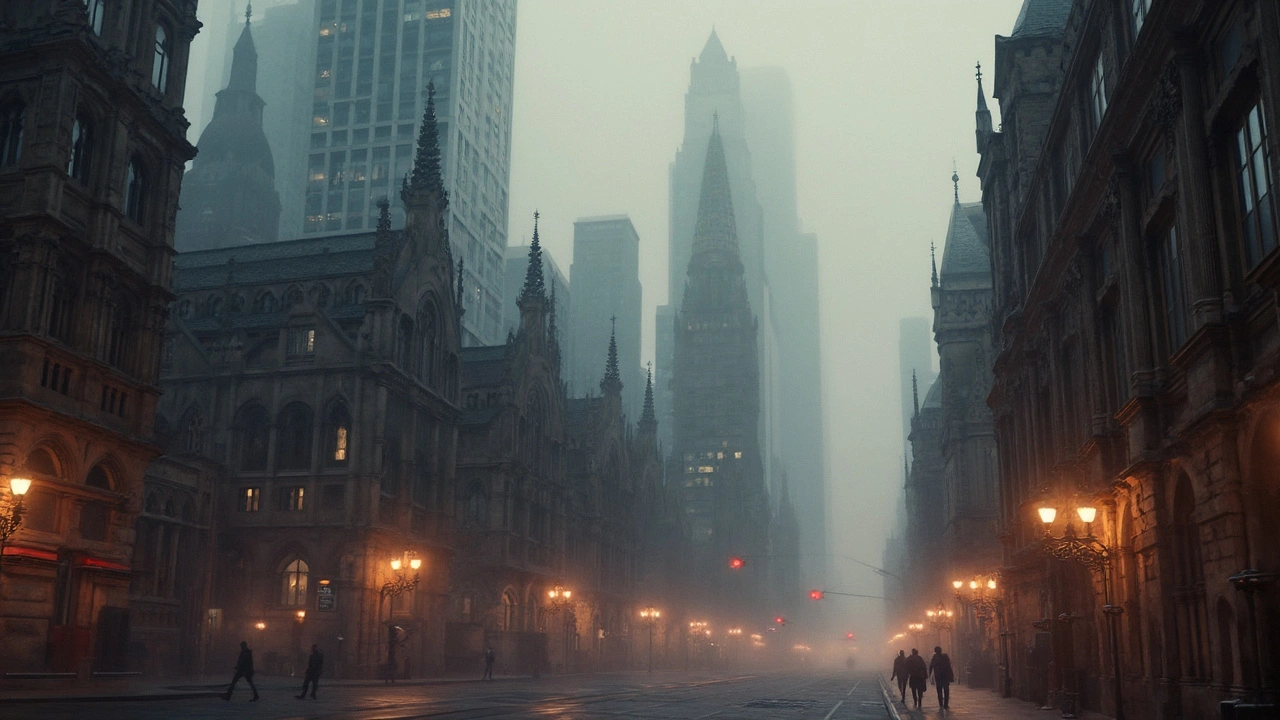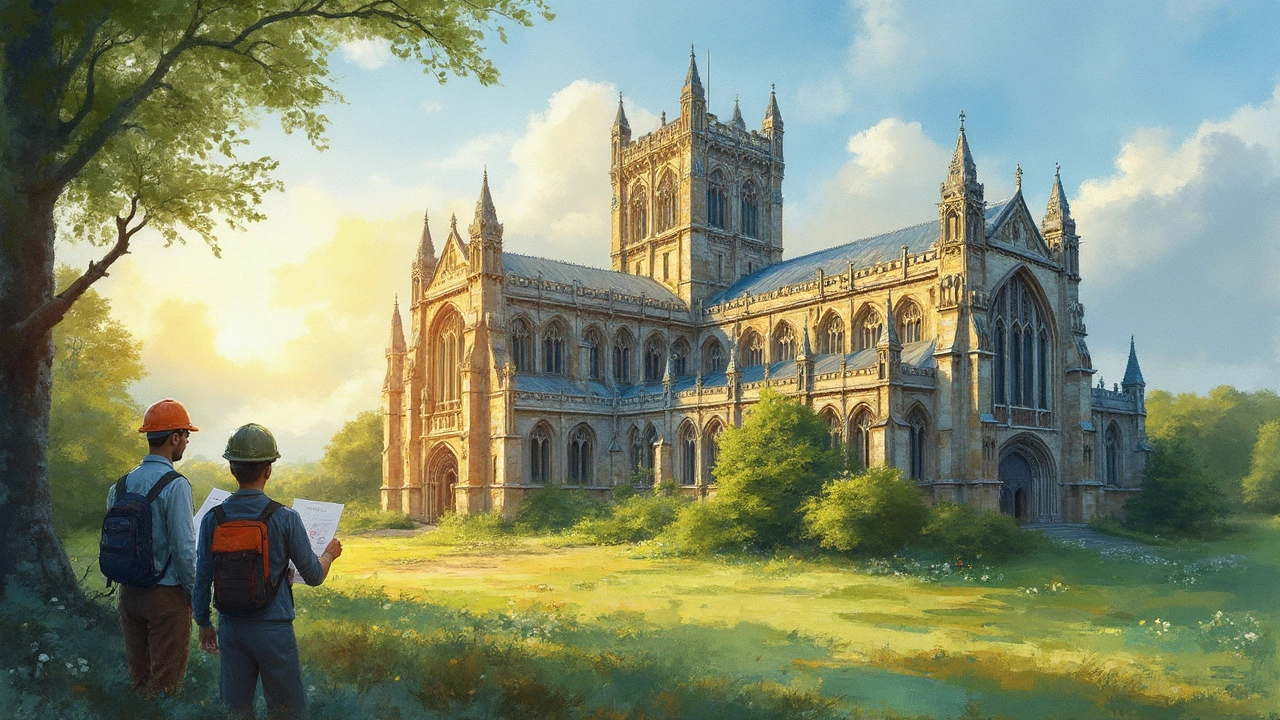Gothic Revival Architecture: Blending Old-World Charm with Modern Flair
 Mar, 17 2025
Mar, 17 2025
Gothic Revival architecture is intriguing because it marries the old with the new. Ever stood before a structure with soaring pointed arches and intricate window tracery and wondered how such medieval charm still fits the modern world? This style peaked in the 19th century but remains a favorite for its unmistakable aesthetic. The beauty of Gothic Revival lies in its ability to echo medieval times while accommodating modern needs.
Exploring this architecture is like stepping into a time machine where historical elements meet contemporary technique. This style naturally features pointed arches, ribbed vaults, and, of course, those striking flying buttresses. These designs aren't just about looks—they're functional too, allowing for taller buildings and larger windows.
So why does Gothic Revival endure? It transforms historical fascination into something alive and relevant today. It allows us to reminisce about the past, all while standing in a plush, modern living room. It bridges the gap between centuries, wrapping buildings in a narrative of time.
- A Peek into Gothic Revival History
- Key Architectural Features
- Modern Adaptations
- Famous Gothic Revival Structures
- Tips for Incorporating Gothic Revival in Modern Spaces
A Peek into Gothic Revival History
The Gothic Revival movement wasn't just a fleeting architectural trend; it was a response to the industrial age's rapid changes. Kicking off mainly in the early 19th century, this style was the romantic reaction to the starkness of modern life. People started to crave the charm and mystery that the medieval style offered, almost like a rebellion against the industrial revolution's cold architecture.
Early Inspirations
Back in the 1740s, when England was buzzing with new ideas, one could argue that Horace Walpole's Strawberry Hill marked one of the first nods to Gothic Revival. This quirky castle with its battlements and dramatic interiors showed just how captivating medieval ideas could be when reimagined.
Growth and Popularity
Flash forward to the 1830s and '40s: England is leading the charge with architects like Augustus Pugin. He believed that the medieval style wasn’t just about looks—it had moral and spiritual significance. The Houses of Parliament in London are a prime example of how Gothic Revival marked an era.
Across the pond, the United States embraced the style too. In fact, the Smithsonian Institution, completed in 1855, stands as a testament to the movement's international reach. Its design featured battlements and pointed arches, bringing a medieval vibe right into the heart of America.
Behind the Design
| Feature | Gothic Influence |
|---|---|
| Pointed Arches | Introduced for their structural advantages and visual drama |
| Ribbed Vaults | Allowed higher ceilings and a more spacious feel |
| Flying Buttresses | Provided stability, enabling larger windows |
These elements weren’t just for show; they revolutionized how buildings were constructed, making them more durable and flexible in design.
By the late 1800s, though, the Gothic Revival started losing its grip in favor of new architectural movements. Yet, its legacy endures, evident in the fascination it still holds today. Whether it’s the atmospheric vibes or the historic touch, this style manages to keep us intrigued.
Key Architectural Features
Gothic Revival architecture is rich with elements that catch the eye and captivate the soul. The moment you spot a gothic revival building, some features are instantly recognizable. Let's get to know what makes these structures so unique and fascinating.
Pointed Arches
Nothing says Gothic quite like a pointed arch. It’s not just for looks—this design distributes weight more effectively, allowing for taller and more intricate buildings. Notice how these arches draw your gaze upwards, creating a sense of awe and wonder.
Ribbed Vaults
Walk inside a Gothic Revival building and look up. Ribbed vaults are a masterpiece of both function and fashion. They support complex and soaring ceilings, adding depth and majesty to any space. You'll find them in many famous examples of this style, turning simple corridors into architectural sentinels.
Flying Buttresses
These are like the hidden heroes. From the outside, flying buttresses give buildings their dramatic feel, seemingly defying gravity. They help spread out the weight of high ceilings and large windows, all while being a stand-out feature.
Intricate Window Tracery
Got a thing for detailed designs? Gothic windows are often adorned with beautiful tracery. Those delicate stone patterns aren't just for decoration—they allow for larger windows and more light, a revelation for the times.
- Gothic revival often emphasized vertical lines to draw the eye upwards.
- Ornate details and decorative patterns were used to tell stories and depict religious events.
- Florid carvings and sculptures often adorned doorways and facades.
In fact, a fascinating element is how these buildings integrate their surroundings, something architects still emulate today. Thought Gothic Revival was just fancy arches and gargoyles? Think again—it’s a confluence of form and function, wrapped in historical narrative.

Modern Adaptations
The reason Gothic Revival still captures imaginations today is thanks to its adaptability in modern design. Architects aren't merely replicating old styles but rather weaving timeless elements into contemporary layouts to create something bold yet familiar. Mixing Gothic features like pointed arches or intricate tracery with glass, steel, and concrete can breathe new life into these historic designs.
Take, for instance, London's King's Cross station. It blends old railway architecture with modern enhancements, featuring a vast glass roof and Gothic-influenced lacework. The result? A stunning space that's both historic and forward-looking.
Seamless Integration
Many modern structures use Gothic Revival design as a base to create interesting contrasts. Think floor-to-ceiling windows inside archways, allowing natural light to flood in while preserving that historic charm. Materials like steel and glass make this easier, as they can be shaped and sized to complement traditional stonework.
Residential Spaces
Even homes are getting a modern Gothic twist. Imagine a sleek kitchen juxtaposed against a backdrop of pointed arches and ribbed ceilings. The key is not to overwhelm the space with too many elements but to integrate details like stained glass or carved wood to accent the space artfully.
Use of Technology
3D printing is another game-changer here. Designers now use this technology to recreate intricate Gothic patterns that would be prohibitively expensive or impossible to handcraft today. This offers a way to maintain the authenticity of the style while keeping costs manageable.
These adaptations ensure Gothic Revival remains not just an echo of the past but a continuing influence on the architecture of tomorrow. By carefully selecting features to include and using them creatively, designers can bring the grandeur of Gothic into our modern lives without missing a beat.
Famous Gothic Revival Structures
When you think about Gothic Revival architecture, certain iconic structures come to mind that highlight the elegance and drama of this style. Let's explore some of the most renowned Gothic Revival buildings that continue to amaze us with their sheer beauty and intricate designs.
1. Houses of Parliament, London
The Houses of Parliament, also known as the Palace of Westminster, is a prime example of Gothic Revival architecture. Designed by Charles Barry and Augustus Pugin, its construction began in 1840 after the original building was destroyed by fire. It incorporates elements like pointed arches and decorative patterns, making it one of the most visited gothic sites globally.
2. St. Patrick's Cathedral, New York
St. Patrick's Cathedral stands out as a central figure in Manhattan's architectural landscape. Completed in 1878, its stunning Gothic Revival façade with pointed towers and detailed carvings sets it apart in the bustling city. The cathedral's interior is just as impressive, with its stained glass windows and beautiful vaulted ceilings.
3. Notre-Dame Cathedral Basilica, Ottawa
This cathedral is not to be confused with the famous Notre-Dame de Paris, but it's certainly a stunning example of Gothic Revival style in Canada. Completed in the 19th century, it dazzles with dual bell towers topped with intricate ironwork. The vibrant interior showcases beautifully painted walls and embellished details.
4. Cologne Cathedral, Germany
Though originally started in the Gothic period, Cologne Cathedral's completion in 1880 marks it firmly in the Gothic Revival period. Known for having the largest façade of any church in the world, it also boasts spires that soars to the sky. It remains a UNESCO World Heritage site, attracting millions of visitors each year.
These structures are just a glimpse into the expansive world of Gothic Revival architecture. Even in the 21st century, they remind us that the blend of historical design with current technology is timeless and continues to inspire modern adaptations.

Tips for Incorporating Gothic Revival in Modern Spaces
Bringing Gothic Revival architecture into your modern home can create a unique and dramatic look. Let's get into how you can achieve this striking style effortlessly.
Focus on Architectural Details
Introduce pointed arches, which are a signature of Gothic Revival, into doorways or windows. These aren't just aesthetically pleasing—they draw the eye upward and add sophistication. Incorporating ribbed vaults in ceilings or hallways also brings an authentic touch that screams old-world charm.
Choose the Right Materials
Opt for materials like stone, wood, and wrought iron. These can be used in various combinations for things like stair railings or light fixtures. These materials not only add texture and depth but echo the authentic feel of historical Gothic buildings.
Create Drama with Lighting
Lighting plays a crucial role in highlighting architectural features. Use chandeliers or wall sconces with intricate designs to cast interesting shadows and add a mysterious ambiance, which is a hallmark of Gothic Revival.
Add Decorative Elements
Lace your space with stained glass accents. These can be implemented in small ways, such as cabinet inserts or decorative window panels, to invite colorful light into a room. Adding elements like vintage mirrors or period-specific furniture can also enhance authenticity.
Mix with Modern Elements
Pairing Gothic Revival elements with modern design instantly updates the look. Think minimalist furniture with bold gothic touches, like a stark-white couch contrasted with a dramatic black gothic-inspired coffee table.
| Element | Purpose |
|---|---|
| Stained Glass | Adds color, character, and historical touch |
| Stone & Wood | Texture and historical accuracy |
| Chandeliers | Create ambiance and focus light |
Whether you're revamping your entire home or just adding gothic touches here and there, these tips can guide you in creating a space that’s both effortlessly chic and timelessly elegant.